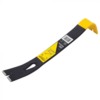Remove the air filter on the driver's side carb. Look down the throat of the carb. Is it full of gas? If so, the carb float/needle valve is stuck (open) and the carb is overflowing. This is not unheard of.
Don't try to start the engine in this condition. You can cause damage if you dump an intake manifold's full of raw gas into a combustion chamber and try to compress it.
Check your oil level. If an intake valve happens to be open in this 'overflowing' condition, the gas will flow through the valve, into the combustion chamber, past the rings, and into the crankcase. If so, change the oil and that part is good-to-go.
If in fact the problem is an overflowing carb and you have repaired the carb or replaced it; before starting the engine remove the spark plugs. 'Dry' out the combustion chambers by blowing air in the spark plug hole. Without the spark plugs installed, roll the engine over for a while on the starter motor with coil wire disconnected (after shooting a light spray of oil through spark plug hole with intention to somewhat lubricate cylinder wall).
Removing the filter and looking down the throat is a quick and easy first step. While in the vicinity of the carb's inspection, feel around the body of the carb for wetness. You might find a loose fuel connection, or a failed accelerator pump diaphragm.





